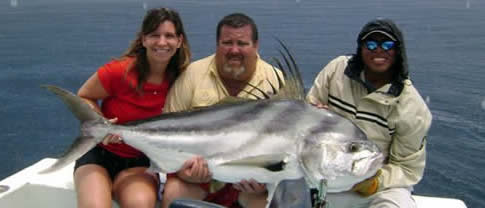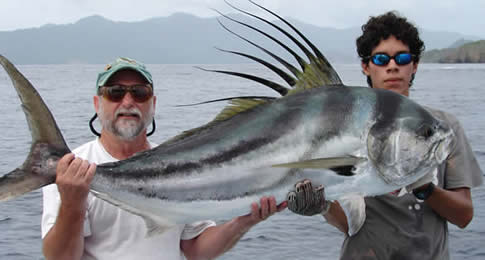Roosterfishing in Costa Rica
Other than sailfish and marlin Roosterfish is the target best appreciated by sports-fishermen who come down looking for an adventure rooster fishing in Costa Rica. With an average weight between 50 and 80 pounds, Roosterfish is a great opponent for any professional or amateur fisherman. An 80 pound Roosterfish is a better fighter than an 80 pound sailfish.

Roosterfish is not a migratory specie, it is instead a territorial one, and it is present year-round. However, a higher number of fishes are caught when water conditions are especially good, no matter what time of the year it is. One of the main reasons for the abundance of this species is the fishing technique used to catch it (live bait and circle hook) plus the catch and release technique shared by all of the Gulf of Papagayo fishermen. Another reason for the abundance of this fish in the area is: there is a large area of fertile grounds where the Roosterfish lives in Papagayo (Bat Islands). These islands became part of the Santa Rosa National Park.
We use to catch Roosterfish close to the shore, near to beaches; however, there are other well-known areas, far from those spots, where this specie is more abundant. The Catalinas and Bat Islands are very productive fishing spots; there, fish are bigger and more abundant. Roosterfish lives in waters no deeper than 100 to 200 feet and as shallow as 10 to 15 feet close to the shore. Their habitat includes the tropics water temperature and correct clarity. Water temperature needs to be like in the tropics -not too cold, not too warm-, and transparency is better when it is a bit cloudy instead of very clear or dirty at all. The better the water conditions are the more catches you can expect.

Many years of experience rooster fishing in Papagayo say that using lures to catch this powerful predator is hard work, and using bait is the best option. Using bait, especially live bait: small bonito, Ladyfish, or rainbow runner are the best option. When live bait is not available a dead bonito will work fine; preparing the fish with the "butterfly" cut technique (cut the bonito fish beginning from its tail to the head side by side trying to remove all its bone). Tuna odor and how it moves makes this kind of bait especially attractive for Rooster.
We, as local sports-fishermen in Papagayo area, practice the catch and release technique to preserve the species. We ask our clients not to keep any Roosterfish. They can take as many photos as possible, returning the fish to the sea; so we can maintain the species for the future and our children.
Other than sailfish and marlin Roosterfish is the target best appreciated by sports-fishermen who come down looking for an adventure rooster fishing in Costa Rica. With an average weight between 50 and 80 pounds, Roosterfish is a great opponent for any professional or amateur fisherman. An 80 pound Roosterfish is a better fighter than an 80 pound sailfish.

Roosterfish is not a migratory specie, it is instead a territorial one, and it is present year-round. However, a higher number of fishes are caught when water conditions are especially good, no matter what time of the year it is. One of the main reasons for the abundance of this species is the fishing technique used to catch it (live bait and circle hook) plus the catch and release technique shared by all of the Gulf of Papagayo fishermen. Another reason for the abundance of this fish in the area is: there is a large area of fertile grounds where the Roosterfish lives in Papagayo (Bat Islands). These islands became part of the Santa Rosa National Park.
We use to catch Roosterfish close to the shore, near to beaches; however, there are other well-known areas, far from those spots, where this specie is more abundant. The Catalinas and Bat Islands are very productive fishing spots; there, fish are bigger and more abundant. Roosterfish lives in waters no deeper than 100 to 200 feet and as shallow as 10 to 15 feet close to the shore. Their habitat includes the tropics water temperature and correct clarity. Water temperature needs to be like in the tropics -not too cold, not too warm-, and transparency is better when it is a bit cloudy instead of very clear or dirty at all. The better the water conditions are the more catches you can expect.

Many years of experience rooster fishing in Papagayo say that using lures to catch this powerful predator is hard work, and using bait is the best option. Using bait, especially live bait: small bonito, Ladyfish, or rainbow runner are the best option. When live bait is not available a dead bonito will work fine; preparing the fish with the "butterfly" cut technique (cut the bonito fish beginning from its tail to the head side by side trying to remove all its bone). Tuna odor and how it moves makes this kind of bait especially attractive for Rooster.
We, as local sports-fishermen in Papagayo area, practice the catch and release technique to preserve the species. We ask our clients not to keep any Roosterfish. They can take as many photos as possible, returning the fish to the sea; so we can maintain the species for the future and our children.